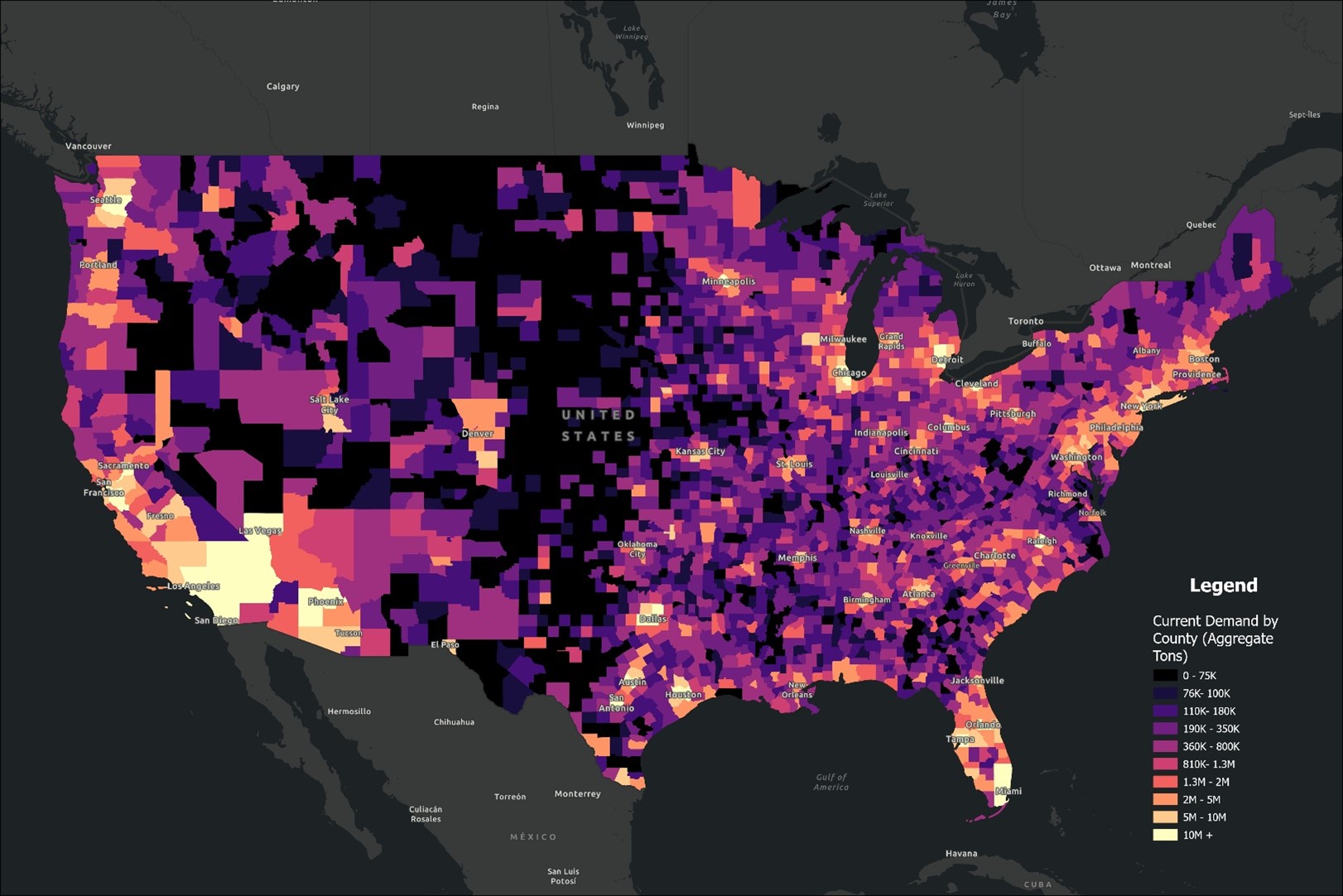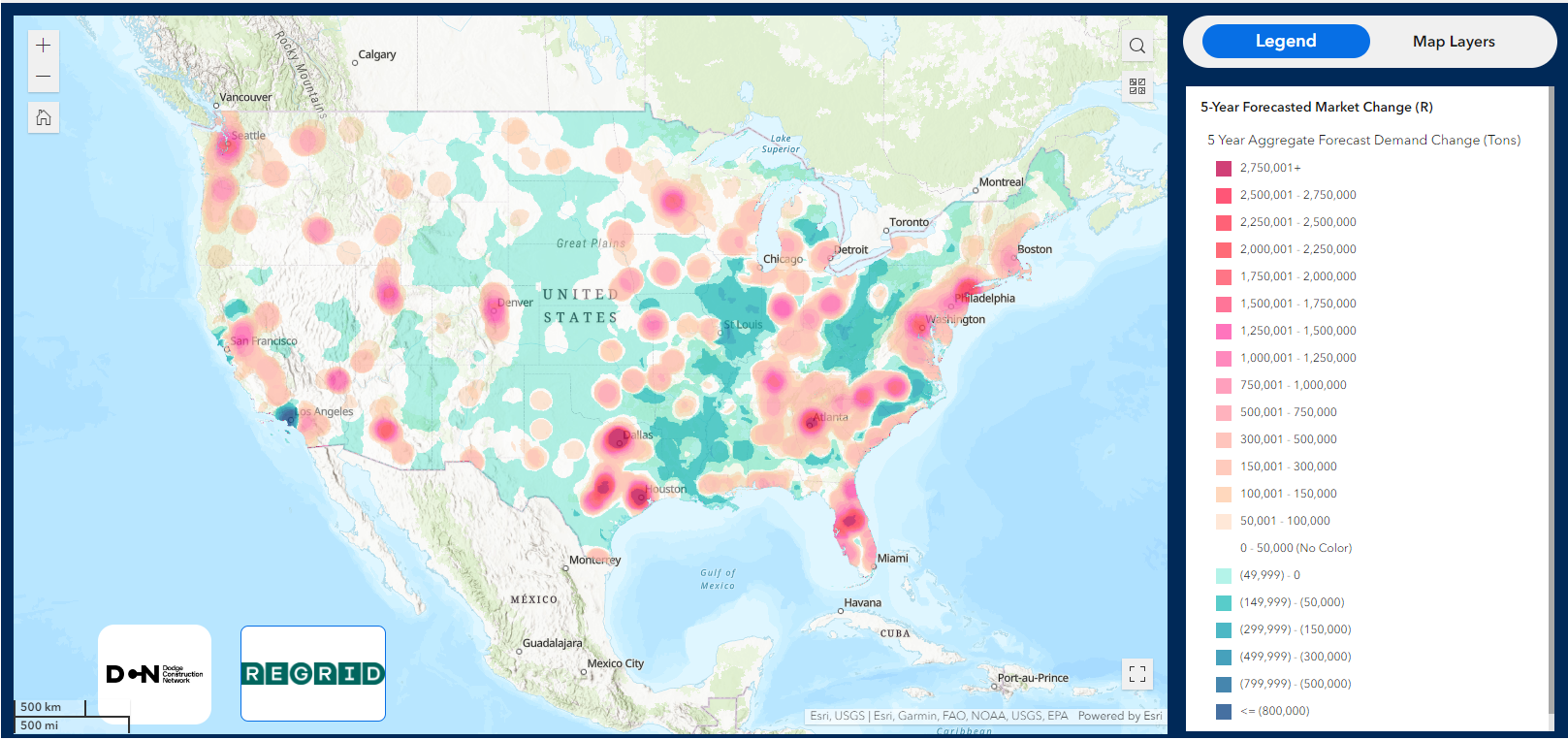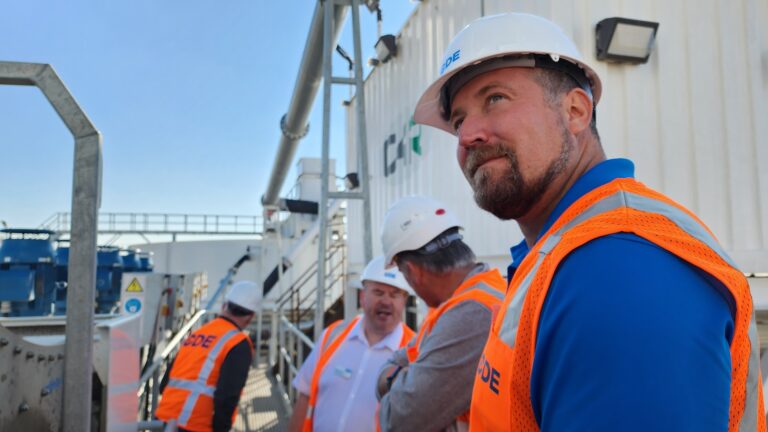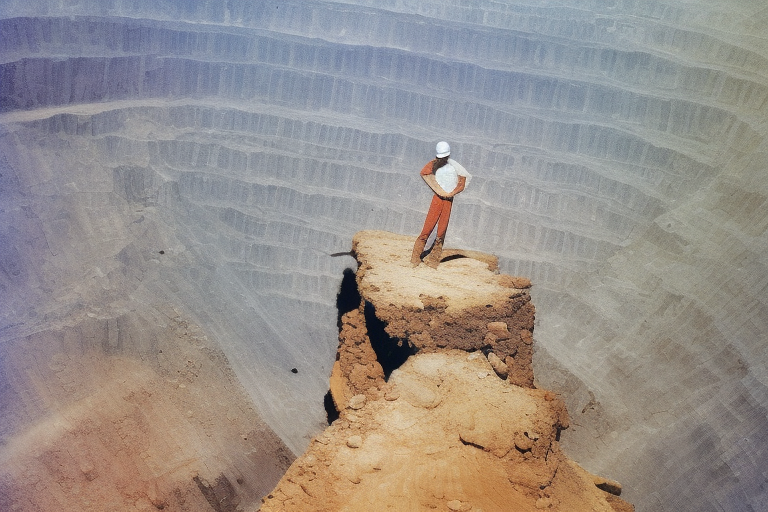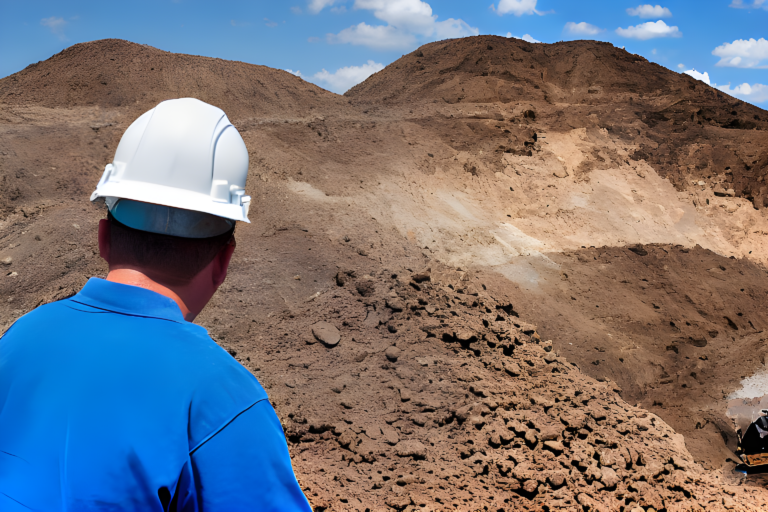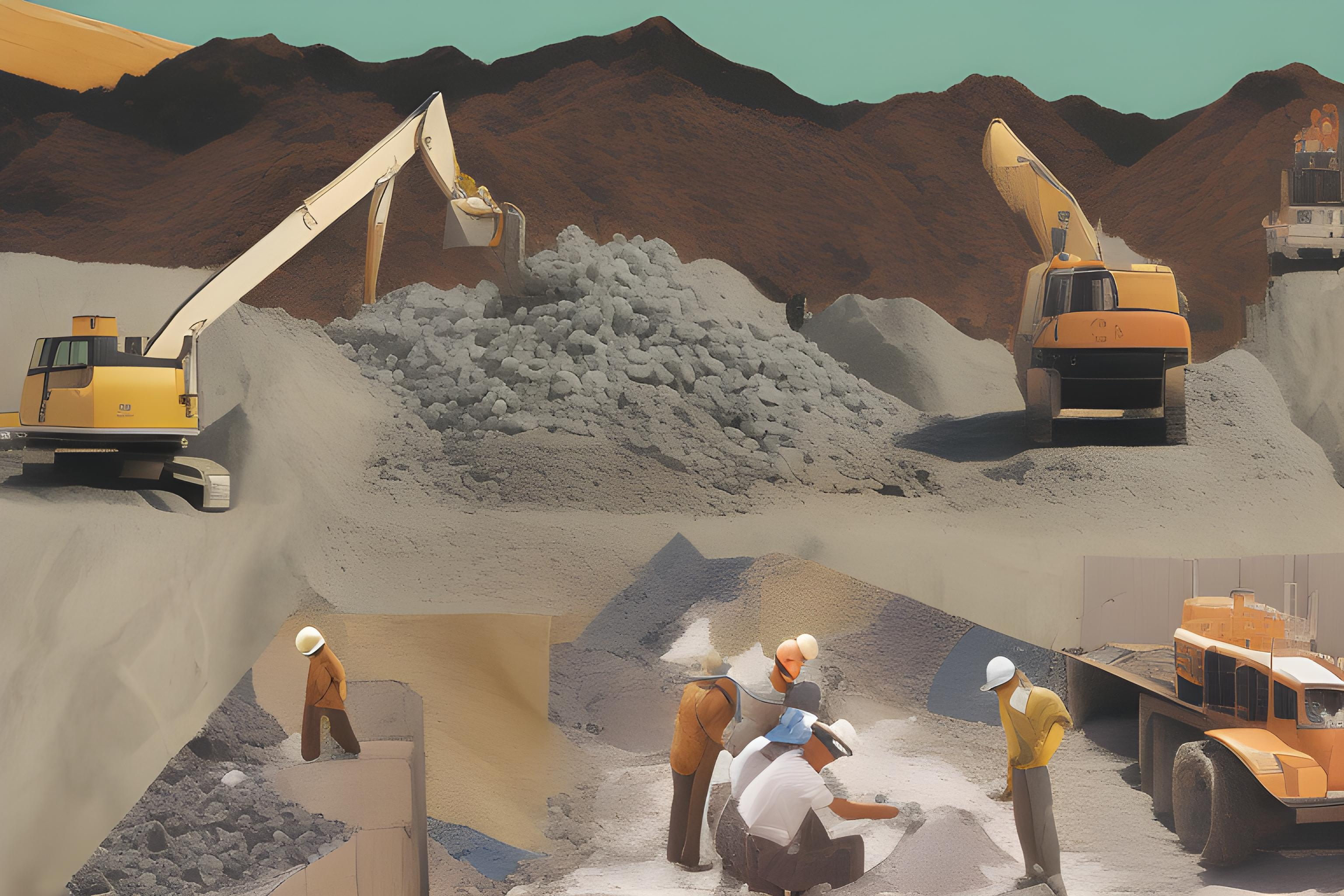Explore the top 25 U.S. counties by estimated aggregate demand in 2024. Learn how construction trends, infrastructure investments, and population growth are driving demand for aggregates across key regions.
Contact Us Today
Contact Us Today
Explore the top 25 U.S. counties by estimated aggregate demand in 2024. Learn how construction trends, infrastructure investments, and population growth are driving demand for aggregates across key regions.
Explore how data analytics and market analysis enhance decision-making in construction aggregate exploration. Learn how integrating geospatial data, market trends, and production insights can optimize site selection and strategic planning.
Maps aren’t just about geographical locations; they can tell stories, reveal trends, and even predict the future. In the construction aggregate industry, understanding these layers of information can be the difference between growth and stagnation. In this article, we showcase five incredibly revealing maps from Mineralocity Aggregates that every industry player should examine.
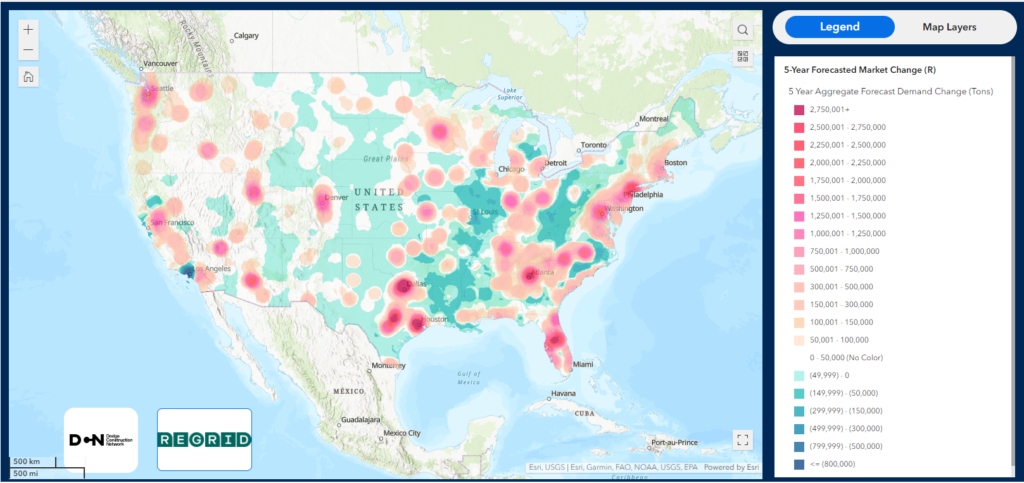
Brief Description: This map shows estimated market change for construction aggregates over the next five years.
Key Insights: East Texas, Atlanta, Tampa, Denver, Phoenix, Salt Lake, and other regions show major growth and significantly increased demand for construction aggregates. On the flip side, Los Angeles is showing a significant decrease in demand, as is most of Illinois and a significant part of the Appalachians.
Business Applications: Shifting demand creates opportunities to shift existing production to growing markets or consider greenfielding new sites near anticipated high demand. In areas of decreasing demand, operations may need to be scaled back or look to other markets or products to succeed.
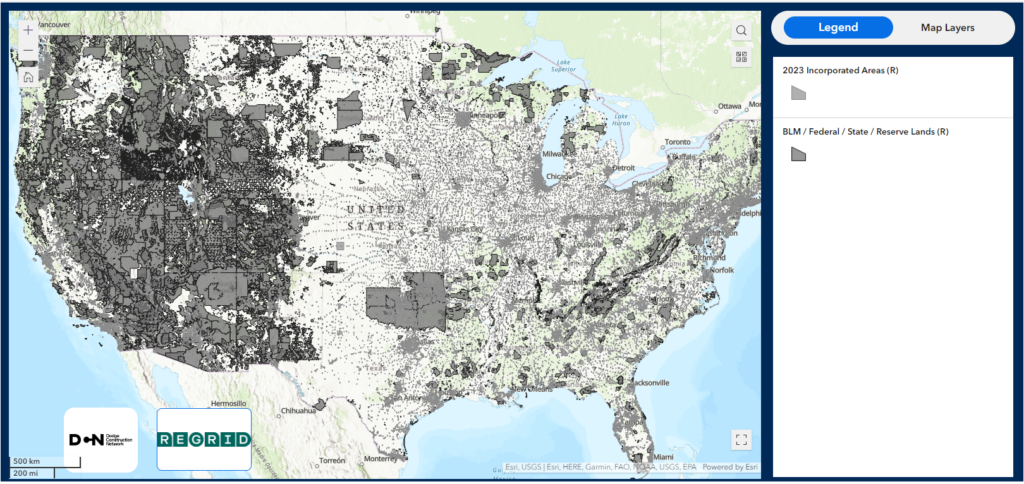
Brief Description: Every region of the United States has a different regulatory framework and fabric of land ownership. This map illustrates how much of the Western United States is covered by federal, state, and tribal lands. The light gray areas on the map illustrate incorporated areas, which are scattered throughout the country.
Key Insights: While not all gray areas are “off limits”, many will have significant challenges or regulatory hoops that will need to be navigated. Construction aggregate producing operations are found throughout many of these regions, but many may be located in areas that would be difficult, if not impossible, to permit today.
Business Applications: This map is useful for locating potential greenfield sites that are outside of incorporated areas or other places – like national parks or wilderness areas – that may be restrictive for development.

Brief Description: What does the map tell us about upcoming infrastructure and construction projects? The areas that are yellow represent the highest amount ($10 billion+) of construction aggregate heavy wide infrastructure, local infrastructure, and non-residential construction projects that are planned. The map is broken down by county. Within the Mineralocity Aggregates application, each of these counties can be explored further to identify the number of projects and anticipated spending for each category.
Key Insights: Much of this information correlates with the findings from our demand heatmap, but there are other areas where major aggregate heavy projects are occurring that don’t directly coincide with growing populations. Emery County, Utah – for example – has over $26.3 billion in planned projects and has only a small rural population.
Business Applications: Portable crushers and other quickly scalable operations can be considered for wide and local infrastructure projects that are in areas that don’t have a large permanent aggregate production base.
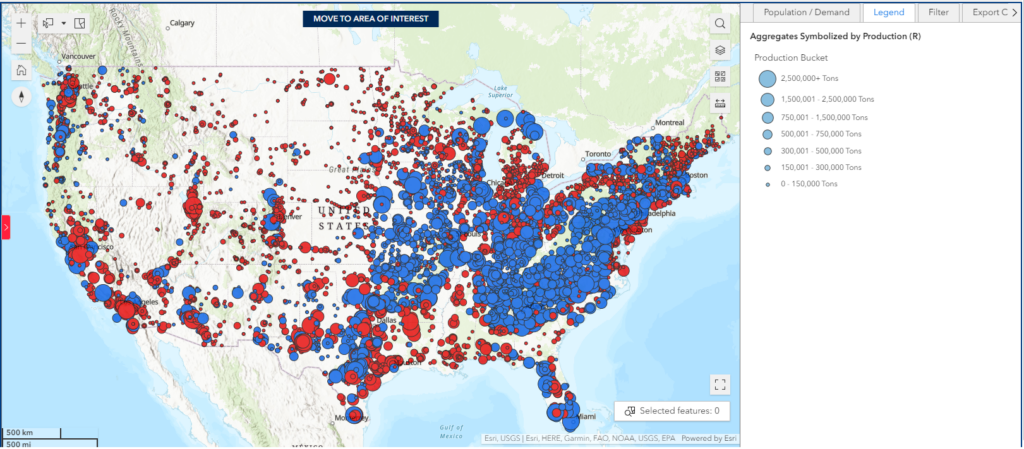
Brief Description: This map shows the relative side of construction aggregate producing operations throughout the United States. Blue circles are crushed stone producing operations (quarries) and red circles produce sand and gravel (pits or dredges).
Key Insights: The size of bubbles generally coincides with major population centers or rail access that ties to major urban centers. The distribution of blue and red circles is dictated by geology. You can see in the Southeastern United States, the curve of the fall line with rock above and coastal plane below with its associated sand and gravel operations. Bonus feature – Mineralocity Aggregates creates an interactive pie-chart that shows the actual market share for major producers within the map view. This is a powerful way to get a quick feel for major regional players when exploring new areas.
Business Applications: How could businesses use this information for their strategic planning? Understanding regional competition is key to discovering how to best strategically be positioned within a new market. Each region of the United States has a unique landscape of producers large and small.
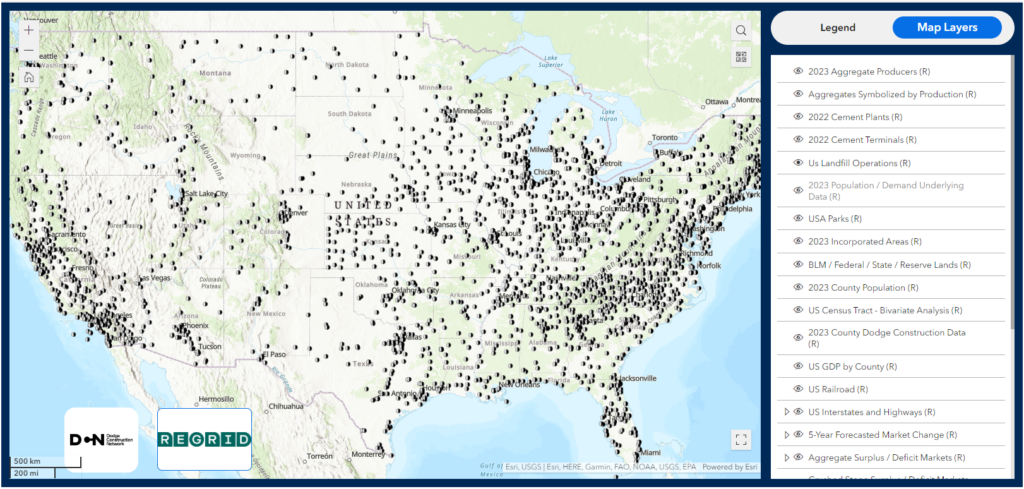
Brief Description: This map shows the location of every landfill location throughout the United States. This is where construction waste, ranging from excavation waste to concrete and asphalt goes to be buried and disposed of.
Key Insights: Recycled aggregate and construction waste is increasingly becoming a larger and more important aspect of the overall aggregate industry. While these recycled materials currently only account for a small percentage of overall consumed tonnage, it is likely that it will grow significantly over the next several decades. Early adapters will be positioned best to succeed.
Business Applications: Placing a recycling facility between major projects and landfills could create lucrative opportunities.
These maps offer a multi-dimensional view of the construction aggregate industry, providing actionable insights for businesses eager to carve out or defend their market share. By leveraging the power of Mineralocity Aggregates’ mapping capabilities, companies can make more informed decisions that lead to sustainable growth.
Ready to dive deeper? Sign up for Mineralocity Aggregates and start exploring these maps and many more for your strategic advantage.
Last week, the Mineralocity Aggregates team had the distinct pleasure of touring Calgary Aggregate Recycling Inc., in Calgary, Alberta. The occasion was a special open house hosted by CDE, an Irish company at the forefront of traditional aggregate processing and cutting-edge recycling technology. This experience provided invaluable insights into the sustainable future of aggregate processing and recycling.
Before diving into the tour details, it’s important to understand the role that CDE plays in the aggregate recycling industry. With the motto, “Engineered for a Circular Economy,” CDE is doing more than just pioneering waste recycling; they’re laying the groundwork for a more sustainable future. They specialize in providing wet processing solutions that divert over 20 million tons of waste from landfills annually. Whether it’s construction and demolition waste, contaminated soils, or hydro excavation waste, CDE transforms these materials into valuable construction resources.
During our tour, we were fortunate enough to see the plant process different types of waste, including excavation and hydro excavation waste. The system, efficient and precise, separates the waste into sorted, washed, and screened streams of rock, sand, and fines.
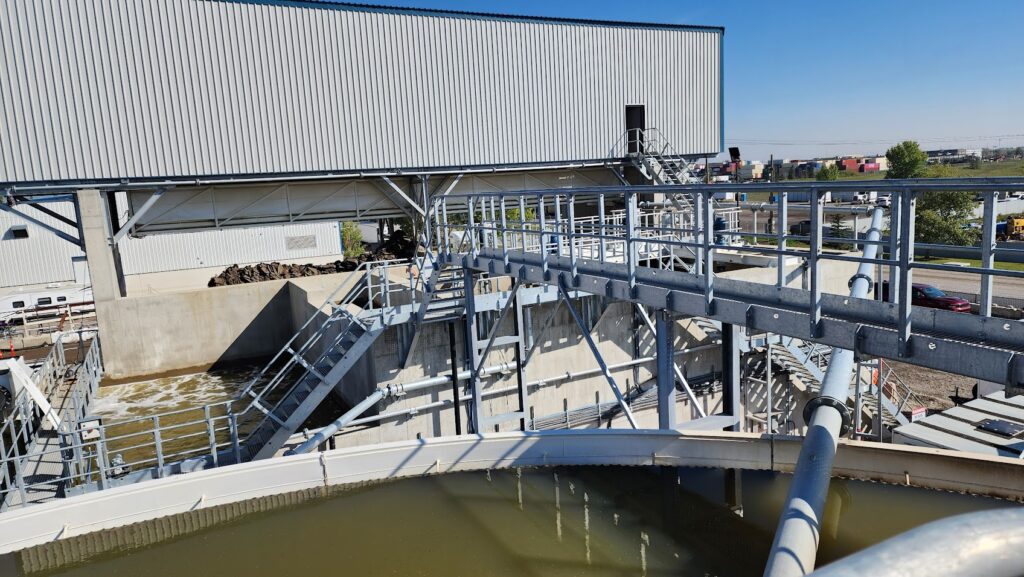
A highlight of the plant’s operation was its closed-loop water system, which recycles ~95% of the water used. This feature not only conserves a critical natural resource but also allows the plant to function with a minimal environmental footprint. This allows for faster permitting and a lower impact footprint.
What stood out during the tour was the plant’s commitment to efficiency. Every aspect of the operation can be monitored from a single dashboard, ensuring that each element runs at peak efficiency to maximize uptime. This is a crucial aspect for any plant that aims to be both profitable and sustainable.
The tour was more than just an educational experience; it was an inspiring vision of the potential that lies ahead. One of the most immediate takeaways was the need to reevaluate our perceptions of waste. Traditionally viewed as something to discard, waste, as demonstrated by Calgary Aggregate Recycling Inc. and CDE, can be a valuable resource.
The advanced technologies we observed have significant scalability and adaptability potential. With CDE’s wet processing solutions capable of diverting over 20 million tons of waste from landfills annually, one can only imagine the global impact if more such facilities were to adopt these technologies. And given that these technologies can be adapted to handle various types of waste—from excavation waste to contaminated soils—it opens doors for widespread industry adoption. We were told that CDE can build these plants to handle as little as 70tph to as much as 700tph. They also offer custom solutions that could potentially be even larger.
While the environmental implications are obvious, there are also substantial economic benefits to consider. The plant’s closed-loop water system, for example, significantly reduces water costs. The ability to monitor every aspect of the operation from a single dashboard allows for real-time decision-making, reducing downtime and boosting profitability.
The success of facilities like Calgary Aggregate Recycling Inc. should encourage policymakers to support sustainable practices in the aggregate industry. By doing so, they can facilitate the transition from traditional waste management to circular economic models that are both profitable and beneficial for the planet.
In a world that’s increasingly cognizant of environmental responsibility, adopting the practices showcased during our tour is more than just good business sense—it’s a societal imperative. Companies that are quick to embrace these technologies not only stand to gain a competitive edge but also become leaders in setting new industry standards.
By embedding these forward-thinking practices into our industry’s operations, we not only mitigate our environmental impact but also create a more resilient, cost-effective, and ultimately more sustainable business landscape. The tour reaffirmed our belief that with the right technologies and practices, the aggregate industry has a bright and sustainable future.
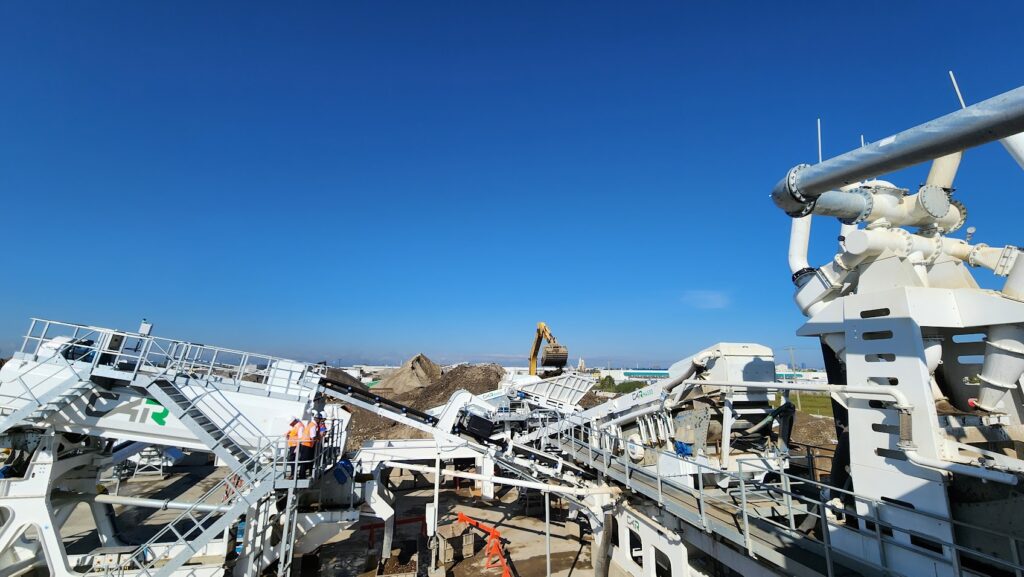
The tour of Calgary Aggregate Recycling Inc. was eye-opening, to say the least. It revealed a glimpse of what is possible when innovation meets sustainability. With companies like CDE leading the way, the future of aggregate recycling is not just promising; it’s imperative. And for teams like ours at Mineralocity Aggregates, it affirms our commitment to be part of this sustainable future.
Navigating the competitive landscape of the construction aggregate industry means being prepared for a multitude of challenges, from new competitors to economic shifts and beyond. Understanding these traditional threats to your market share is vital for long-term success. This article outlines some of these key factors and offers strategies to help you maintain and grow your market share.
The arrival of a new competitor in the construction aggregate industry can significantly impact your business, potentially eating into your market share. These newcomers often come armed with aggressive pricing strategies, innovative products, or even a unique marketing approach, designed to lure away even your most loyal customers.
The first step in effectively countering new competition is recognizing their presence as early as possible. This can be accomplished through consistent market research, watching for permitting applications, monitoring industry publications, and even keeping an ear to the ground among your customer base and suppliers.
Once you’ve identified a new player in the field, a detailed competitor analysis is essential. This will help you understand their strategies, strengths, weaknesses, and most importantly, their potential impact on your market share. Your SWOT (Strengths, Weaknesses, Opportunities, and Threats) analysis should be updated to include this new competitor. This will help you identify any adjustments needed in your own value proposition.
Based on your SWOT analysis, review your value proposition to identify how you can differentiate your offering from the new competitor. This might involve enhancing product features, revising pricing structures, or improving customer service. It’s crucial to remind your customers why they chose your brand in the first place.
The market conditions are ever-changing, especially with a new competitor stirring the waters. Continuously monitor their strategies, customer feedback, and their impact on your market share. This is a dynamic process that will likely require you to adapt your own strategies over time.
Platforms like Mineralocity Aggregates can provide data-driven insights into customer behavior, supply chain dynamics, and market trends. Utilize this data to adapt and refine your strategies for defending your market share against new competitors.
By understanding the strategies and tactics of new entrants, and responding proactively, you can mitigate the impact on your market share and even discover new opportunities for growth.
Local and regional economic conditions can dramatically affect your market share in the construction aggregate industry. Economic downturns often lead to reduced construction activities, while booms can bring about increased competition and higher operational costs. Here’s how to safeguard your market share during such uncertain times.
Be proactive in monitoring key economic indicators relevant to your industry. These might include interest rates, unemployment levels, and construction starts. Understanding these indicators can help you predict how market demand will be affected.
In times of economic instability, a rigid business model can be a liability. Flexibility allows you to quickly adapt to changing circumstances, whether it’s adjusting production levels, diversifying product offerings, or temporarily scaling back on certain operations.
Maintaining a healthy cash flow is crucial, especially during economic downturns. Consider renegotiating terms with suppliers or exploring alternative financing options to bolster your liquidity. This financial cushion can provide you with the room to maneuver when times get tough.
Cost optimization is not merely about cutting expenses; it’s about making your operation leaner and more efficient. This might include improving operational efficiencies or renegotiating contracts with suppliers. Any savings can be redirected to strategies aimed at maintaining or increasing market share.
Utilize risk management tools and strategies to prepare for potential financial downturns. This could include securing long-term contracts with favorable terms or hedging against market variables that could affect your costs, such as fuel prices.
Utilize data analytics platforms like Mineralocity Aggregates to gain insights into customer behavior, pricing elasticity, and market trends. This enables you to make informed decisions and develop adaptive strategies that can weather economic fluctuations.
By being prepared and adaptive, you can better defend your market share when economic conditions shift. Uncertain times often bring both challenges and opportunities—being agile and prepared can help you capitalize on the latter.
The construction aggregate industry often faces dramatic fluctuations in demand due to the cyclical nature of large construction projects. Whether it’s the commencement of a massive infrastructure project or the winding down of a long-term development, these shifts can significantly affect your market share. Here’s how to stay ahead:
Staying informed about local and regional construction activities is essential. Subscribe to industry journals, participate in local business forums, and maintain relationships with key players to gather early intelligence about upcoming projects or project completions.
When you anticipate an increase in demand due to an upcoming project, effective stockpile management becomes critical. You may need to ramp up production in advance to meet this demand, which will also necessitate calculating storage costs and considering the shelf-life of your aggregates.
When faced with a sudden influx of large projects, your operation must be scalable. This could mean leasing additional machinery, hiring temporary labor, or partnering with other producers. Scalability allows you to capitalize on increased demand without overextending your resources.
Large projects might require bulk quantities but at more competitive pricing. Revisiting your pricing strategy in such cases is crucial. Offering tiered pricing or early-bird discounts can not only secure a large project but also protect your market share.
As large projects wind down, demand for aggregates will drop, sometimes significantly. Having a transition plan can help you adjust your production levels and shift your focus to other markets or smaller projects. Failing to prepare for this drop in demand can result in overstock and reduced profitability.
Platforms like Mineralocity Aggregates can offer invaluable insights for predicting future demand patterns. Utilizing predictive analytics helps you prepare for market fluctuations, allowing you to make well-informed decisions regarding production, pricing, and distribution.
By staying proactive and adaptable, you can navigate the often unpredictable tides of project-based demand, defending and even growing your market share in the process.
In a constantly evolving landscape like the construction aggregate industry, defending your market share is a never-ending task. The threats are many and varied—from new competitors disrupting the market to economic uncertainties that can shake even the most stable of businesses. On top of that, the very nature of the industry is such that demand can ramp up or plummet based on the ebb and flow of large construction projects.
Adaptability and proactivity are your best allies in such an environment. Keeping an eye out for new entrants can help you maintain your competitive edge. During uncertain economic times, a well-honed financial strategy is your best defense, helping you to survive and even thrive. Similarly, understanding the dynamics of demand, particularly during the launch or conclusion of major projects, allows for smarter stockpile management, more dynamic pricing strategies, and a better-planned operational scale.
The thread that weaves all these strategies together is data. Advanced analytics platforms like Mineralocity Aggregates offer crucial insights that can shape your strategies and decisions. These platforms allow you to predict trends, understand market dynamics, and tailor your operations in a manner that not only defends your current market share but sets the stage for future growth.
In the end, the key to successfully defending and expanding your market share lies in your ability to be proactive rather than reactive. Strategies must be continuously reviewed, plans regularly updated, and your finger always kept on the pulse of industry shifts and changes.
If you’re eager to get even more insights into defending your market share, consider booking a free demo today to learn more about the Mineralocity Aggregates platform and how you can immediately leverage its powerful insights in your business!
In the competitive landscape of the construction aggregate industry, holding onto your market share is often as challenging as expanding it. The key to retaining your slice of the pie lies in proactive strategies that span across various domains, including pricing, customer retention, and innovation. In this guide, we’ll dive into each of these critical pillars and how they can be effectively managed for defending market share in the aggregate industry.
Setting the right price for your aggregates is not just a matter of arithmetic; it’s a strategy that can make or break your market share. Pricing influences not only immediate sales but also impacts long-term customer relationships. Here’s how to wield pricing as a powerful tool for defending market share in the aggregate industry:
Understanding Your Costs
Before you even think about setting a price, it’s crucial to have a clear understanding of your production and operational costs. This includes everything from raw materials to labor, transportation, and overhead. Knowing your costs sets the floor for your pricing strategy and helps avoid selling at a loss, a cornerstone principle in defending market share in the aggregate industry.
Value-Based Pricing
Gone are the days when the lowest price won the customer. Today’s buyers are increasingly looking for value, which encompasses not just the product but also the entire customer experience. Can you provide faster delivery times? Is your customer service exceptional? Are your aggregates of higher quality compared to competitors? All of these factors can justify a slightly higher price if customers perceive they are getting better value.
Dynamic Pricing Strategies: A Real-World Example
In the volatile market of construction aggregates, static pricing can be a severe disadvantage. Consider implementing dynamic pricing, where prices are adjusted based on real-time market conditions such as fluctuations in demand, seasonal trends, or competitor pricing. For instance, a mine recently required customers to purchase one ton of concrete sand (of which they had an excess) in order to purchase a ton of gravel (which was more scarce and valuable in the area). This not only enabled the mine to move inventory efficiently but also provided customers with a bundled solution, meeting multiple needs in one transaction. Such innovative strategies can be automated using advanced data analytics platforms like Mineralocity Aggregates, which closely monitor market conditions and offer valuable insights for defending market share in the aggregate industry.
Discounting and Bundle Pricing: A Tactical Edge for Defending Market Share
Strategic discounting and bundle pricing are effective ways to increase sales volumes, thereby defending or even growing your market share. For example, offering a discount for bulk orders or longer-term contracts can incentivize customers to make larger, more committed purchases.
Communication and Transparency in Pricing
Any pricing strategy is only as effective as its communication. Make sure your customers understand your pricing model, what they’re paying for, and why it offers better value. Transparency can go a long way in building trust, an essential factor in defending market share in the aggregate industry. By meticulously crafting your pricing strategies, you’re not just setting a price; you’re defining the value of your brand and product in the eyes of the customer.
Keeping an existing customer is generally cheaper and more efficient than acquiring a new one. The aggregate industry is no different. Focus on customer service, transparent communication, and reliable delivery to keep your customers coming back. Additionally, customer loyalty programs or long-term contracts can be an excellent way to secure steady business while also locking in a portion of your market share.
The saying “innovate or die” holds particularly true in the construction aggregate industry. Innovation isn’t confined to the product alone; it extends to processes, supply chain management, and even customer interaction channels. Embrace technology solutions like the Mineralocity Aggregates platform to gather data-driven insights, predict future demand, and streamline operations.
Platforms like Mineralocity Aggregates not only assist in predicting future trends but also offer the ability to visually compare current and future supply and demand balances side by side. In an industry where the margins can be thin, these data-backed insights can be game-changing when it comes to defending market share in the aggregate industry.
Defending your market share requires a multifaceted approach that spans pricing, customer retention, and innovation. While each of these pillars is essential, their true power lies in their integration. Utilizing platforms like Mineralocity Aggregates can offer invaluable insights and data, ensuring that your strategies are not just reactive but proactively aligned with market dynamics.
Intrigued by the strategies discussed in this article? To learn more, download our Top Aggregate Producers Report for 2023 and get ahead in your market share defense game.
In the ever-evolving landscape of the construction aggregate industry, one constant remains: the need to predict supply and demand accurately. Businesses that can forecast effectively find themselves better positioned in their markets and more prepared for future challenges. In this article, we delve into the rudiments of supply and demand in construction aggregates and how you can forecast future needs. We also introduce a groundbreaking tool, Mineralocity Aggregates, that can transform the way you look at market data.
The principles of supply and demand are universal, and in the aggregate industry, these factors can be influenced by a myriad of variables. However, a fundamental way to gauge market demand is by looking at the population within a defined radius of your operation—generally, 40 to 60 miles—and multiplying it by the regional per-capita annual construction aggregate consumption number. According to the National Stone, Sand & Gravel Association (NSSGA), the average stands at about 7-10 tons per capita. This number can vary significantly from year to year, so it is important to use a long term average.
To establish the supply and demand balance, you take the estimated supply in a specific region and subtract the demand. The resulting number will indicate whether you are dealing with a surplus or a deficit.
Estimating future demand is not a shot in the dark but a calculated extrapolation based on available data. One crucial element is population growth. By utilizing figures from sources such as the U.S. Census Bureau, it’s possible to estimate demand for the next 5, 10, 15, or even 20 years.
What if we told you that there’s a tool that has already calculated future demand for the entire United States, enabling you to compare current and future supply and demand side by side? Enter Mineralocity Aggregates.
With this platform, you can go a step further and quantify the value of future demand in each U.S. county. Leveraging proprietary data provided by Dodge Construction Network, we give you insights into planned but not yet started infrastructure projects that are likely to be aggregate-intensive.
Predicting and understanding market trends is crucial for the longevity of your business. Whether it’s monitoring the pulse of local demographics or keeping an eye on regional infrastructure projects, having the right data and tools at your disposal is a game-changer. Mineralocity Aggregates not only delivers this but also offers a user-friendly interface that makes the entire process efficient and effective.
Understanding the basic dynamics of supply and demand, combined with strategic forecasting, can make all the difference in positioning your aggregate business for long-term success. Mineralocity Aggregates simplifies this complex task, putting comprehensive data and predictive analytics at your fingertips.
Ready to get ahead of the curve? Request a free demonstration today to explore the depth and breadth of our platform’s capabilities.
In an era defined by rapid urbanization and increasing demand for infrastructure, the construction aggregate industry plays a pivotal role. However, as the need for raw materials grows, so does the importance of environmentally conscious quarrying. Implementing green practices in greenfield site selection not only benefits the environment but can also pave the way for operational efficiencies and an enhanced brand image. Let’s dive into the myriad of ways eco-friendly quarrying can be approached, from the early stages of site selection to advanced operational tactics.
Selecting sites strategically close to major transportation hubs is a pivotal step in eco-friendly quarrying.
Rail Transportation: Rail remains one of the most energy-efficient means of bulk transport. By opting for sites near rail lines, quarries can directly load aggregates onto trains, which drastically reduces the carbon footprint per ton of material transported. According to the Association of American Railroads, railroads are, on average, four times more fuel efficient than trucks. This translates to fewer greenhouse gas emissions for the same freight load, making it a greener choice.
Reduced Road Traffic: Beyond the environmental implications, proximity to transportation routes minimizes truck travel distances, leading to reduced road congestion, fewer accidents, and diminished road wear and tear. This has an indirect environmental benefit by reducing the need for frequent road repairs, which itself is a carbon-intensive activity.
Dynamic Routing: Advanced technologies now allow quarry managers to utilize dynamic routing. By having a site close to multiple transport options, managers can dynamically select the most efficient transportation method based on real-time data, like traffic conditions, further reducing the environmental impact.
Intensive planning before breaking ground can have a profound impact on the sustainability of a quarry. Leveraging the expertise of seasoned professionals, such as those from Burgex Mining Consultants, can greatly optimize this process.
Efficient Pit Designs: By modeling the deposit and understanding the geological contours, quarries can design pits that follow the natural layers of aggregates. This allows for a more streamlined extraction process, minimizing waste and energy consumption. Burgex’s team, with their extensive experience, can provide invaluable insights into maximizing the efficiency of pit designs.
Optimal Routing: Within the quarry, the routing of machinery and transport vehicles plays a crucial role in efficiency. Shorter routes and fewer idle times for machinery, achieved through intelligent routing based on real-time conditions, can lead to substantial fuel savings. Collaborating with experts like those at Burgex can help operations fine-tune their internal routing for maximum efficiency.
Methodical Extraction Sequences: By planning the sequence of extraction, quarries can ensure that they’re always working on the most accessible and easiest-to-extract areas. This reduces the time machinery spends breaking and moving material, decreasing fuel consumption and machinery wear. Again, tapping into the knowledge base of mining consultants can refine this sequencing.
Future-proofing with Scalability: Good planning also involves considering future expansions and deeper excavations. By keeping future scalability in mind, operations can ensure that their initial designs don’t lead to inefficiencies or extensive modifications later on. A partnership with Burgex can be instrumental in providing a long-term vision, ensuring that the site remains both productive and eco-friendly in the years to come.
Incorporating recycling practices into your operations not only reuses materials but also reduces the need for virgin extraction, saving energy and reducing environmental impacts.
On-site Processing: Having a dedicated area for the recycling and processing of old aggregates means that materials can be reclaimed and repurposed directly on-site. This eliminates the need for transport to external recycling facilities and reduces the demand for virgin materials.
Source External Waste: Encourage local construction projects to send their waste concrete and asphalt to your facility. By recycling this material into new aggregate products, you’re diverting waste from landfills and reducing the energy and resources required to produce new aggregate from scratch.
Diverse Product Offering: Aggregate recycling can produce a variety of products, from base materials for roads to high-quality aggregates for new concrete. Offering a diverse range of recycled products can help cater to different market needs, potentially opening new revenue streams.
Promote the Green Initiative: Beyond the environmental benefits, promoting the fact that your operation recycles can be a unique selling proposition. It can appeal to eco-conscious customers and businesses looking to boost their own sustainability credentials by sourcing recycled materials.
Incorporating energy-efficient machinery into the mining and processing operations can drastically reduce the carbon footprint and operational costs of a quarry.
Modern Equipment: Newer machinery models are typically designed with fuel efficiency and reduced emissions in mind. Investing in modern excavators, loaders, crushers, and haul trucks can mean burning less fuel for the same amount of work. It’s not just about engine efficiency—advanced hydraulic systems, better aerodynamics, and smarter computer controls all contribute to improved energy usage.
Hybrid and Electric Machinery: As the construction and mining industries evolve, there are more options available for hybrid and electric machinery. These machines offer the potential for zero on-site emissions and can be powered by renewable energy sources. They also tend to have fewer moving parts, which can reduce maintenance needs and downtime.
Automated Systems: Automation in machinery can lead to more consistent operation, minimizing wasteful practices. For instance, automated load and haul systems can optimize routes in real-time, ensuring trucks take the most efficient path and are loaded to their optimal capacity.
Regular Maintenance: Keeping machinery well-maintained ensures that it operates at peak efficiency. This includes regular oil changes, filter replacements, and engine tune-ups. Dirty or poorly maintained equipment can consume more fuel and produce more emissions.
Operational Training: Ensuring that operators are well-trained can have a significant impact on fuel consumption. Operators who understand the most efficient ways to use their machinery can reduce unnecessary idling, optimize loading techniques, and generally ensure that the equipment is used in the most energy-efficient manner possible.
Monitoring and Reporting: Using technology to monitor the fuel consumption and efficiency of machinery can be invaluable. Real-time monitoring systems can provide instant feedback, allowing for adjustments in operations. Regular reporting can identify trends, leading to better long-term decision-making about equipment and practices.
By emphasizing energy efficiency in equipment selection and operation, quarry owners can realize both environmental and economic benefits. Reduced fuel consumption translates to lower operating costs, while reduced emissions and a smaller carbon footprint can enhance the operation’s sustainability profile.
The environmental impact of quarrying extends beyond just the extraction phase. When planning a greenfield site, considering the end-use and eventual restoration of the mined area can make a significant difference in terms of ecological benefit and public perception.
Phased Restoration: Instead of waiting until the end of the quarry’s life, consider restoring areas in phases as they become exhausted. This approach can quickly return portions of the land to a more natural state, allowing ecosystems to begin their recovery process sooner.
Native Plant Reintroduction: Use native plants in the restoration process to ensure the returned land is suitable for local wildlife. Native plants help prevent soil erosion, maintain local water quality, and provide habitat and food sources for native species.
Water Management: Many quarries end up with significant water features post-mining. Properly managing these can create valuable wetland habitats. This might include measures to ensure clean water, managing water levels for wetland birds, or introducing native fish species.
Collaboration with Ecologists: Partner with local ecologists and conservationists to determine the best restoration strategies. They can provide insight into what species may be most beneficial to reintroduce and how best to structure the landscape for biodiversity.
Community Engagement: Involve the local community in the restoration process. This could be through educational programs, community planting days, or simply keeping them informed about the restoration progress. A community that feels involved and informed is more likely to support the restoration efforts.
Post-Restoration Monitoring: Even after restoration, it’s essential to monitor the land to ensure the intended ecosystems establish and thrive. This might involve tracking plant growth, surveying for wildlife, or ongoing water quality tests.
A well-implemented restoration plan not only mitigates the environmental impacts of quarrying but can also transform exhausted quarries into valuable community and ecological assets. Whether they become local parks, wildlife habitats, or community water features, restored quarries can play a vital role in local ecosystems.
In many regions, water is a precious resource, and its conservation within the aggregate industry isn’t just good for the environment; it’s often an economic necessity. Here are strategies that emphasize sustainable water use:
Closed-Loop Water Systems: Use a closed-loop system that recycles and reuses water in the quarrying process. Such systems substantially reduce the demand for fresh water by continually treating and reusing the same water in operations.
Rainwater Harvesting: Implement rainwater harvesting systems to capture and store rainwater. This harvested water can then be used for various site operations, including dust control, washing, and even in restorative processes.
Drought-Resistant Landscaping: For any landscaping or restoration activities, choose native or drought-resistant plants that require minimal irrigation.
Evaporation Prevention: Large water bodies, often a byproduct of quarrying, can lose significant amounts of water through evaporation. Implementing floating covers or shade balls can reduce evaporation rates.
Advanced Filtration Systems: Utilize modern filtration systems that can treat and purify water more efficiently, ensuring that a greater volume is available for reuse.
Regular Monitoring: Regularly monitor water usage and identify any leaks or inefficiencies. Small, unnoticed leaks over time can result in significant water loss.
Educate Employees: Ensure that all staff are educated about the importance of water conservation and are trained in best practices to minimize waste.
Engage with Local Water Authorities: Collaborate with local water boards or authorities to understand regional water concerns and get guidance on best conservation practices tailored to the area.
Water conservation isn’t just an environmental concern; it’s also an operational one. By reducing the demand for fresh water and maximizing the reuse of existing supplies, aggregate producers can ensure more sustainable, long-term operations while also lowering operational costs.
The environmental footprint of an aggregate operation isn’t just about land and water; it extends to the air and sound environment as well. Reducing noise and dust not only benefits the environment but also the surrounding communities and the overall public perception of the operation. Here’s how quarrying operations can tackle these two pervasive challenges:
Advanced Machinery: Utilize machinery that is designed to produce less noise. Modern equipment often comes with improved sound dampening and controls that minimize their acoustic footprint.
Strategic Planting: Planting trees and shrubs around the site’s perimeter can act as a natural barrier to both noise and dust, aiding in their absorption.
Dust Suppression Systems: Invest in state-of-the-art dust control systems, which can range from misting cannons to foam suppression technology, to keep dust levels down.
Proper Maintenance: Regularly service machinery to ensure they operate efficiently and quietly. A machine in good repair is typically quieter than one that’s worn out.
Operational Timing: Limit the loudest operations to the middle of the day when background noise is generally higher, and fewer people are likely to be disturbed.
Haul Road Maintenance: Regularly maintaining and dampening haul roads within the site can reduce the amount of dust kicked up by transport vehicles.
Noise Barriers: In areas particularly sensitive to noise, consider erecting temporary or permanent noise barriers. These can be in the form of earthen berms, acoustic fences, or specialized panels.
Regular Monitoring: Utilize noise and air quality monitors to continually check the levels of noise and particulates emanating from the site. Monitoring helps ensure compliance with regulations and can highlight areas that need attention.
Community Engagement: Engage with the local community to understand their concerns about noise and dust. An open dialogue can lead to tailored solutions and foster goodwill.
Being proactive in reducing noise and dust can drastically improve community relations and make the permitting process smoother in expansions or new ventures. It’s a tangible way of showing commitment to sustainability and corporate responsibility.
In today’s world, it’s not enough to just mine aggregates; it’s essential to do so responsibly, considering the environment, communities, and the future. As we’ve explored, the strategies for eco-friendly quarrying are multifaceted, ranging from optimizing transportation to pioneering noise and dust reduction techniques. Every step in the right direction, whether it’s investing in energy-efficient machinery or implementing water conservation strategies, counts towards a larger goal of sustainable aggregate production.
Moreover, embracing these practices isn’t just about responsibility—it’s also about forward-thinking business. As communities become more environmentally conscious, adopting green practices will not only foster positive community relations but also potentially pave the way for smoother permit approvals and renewed licenses in the future.
With the right partners, like Burgex Mining Consultants, and resources like Mineralocity Aggregates that provide invaluable insights for greenfield site selection, aggregate producers can be well-equipped to navigate the intricacies of sustainable operations. As we look ahead, the merging of industry and eco-conscious practices will undeniably be the hallmark of leading aggregate producers worldwide.
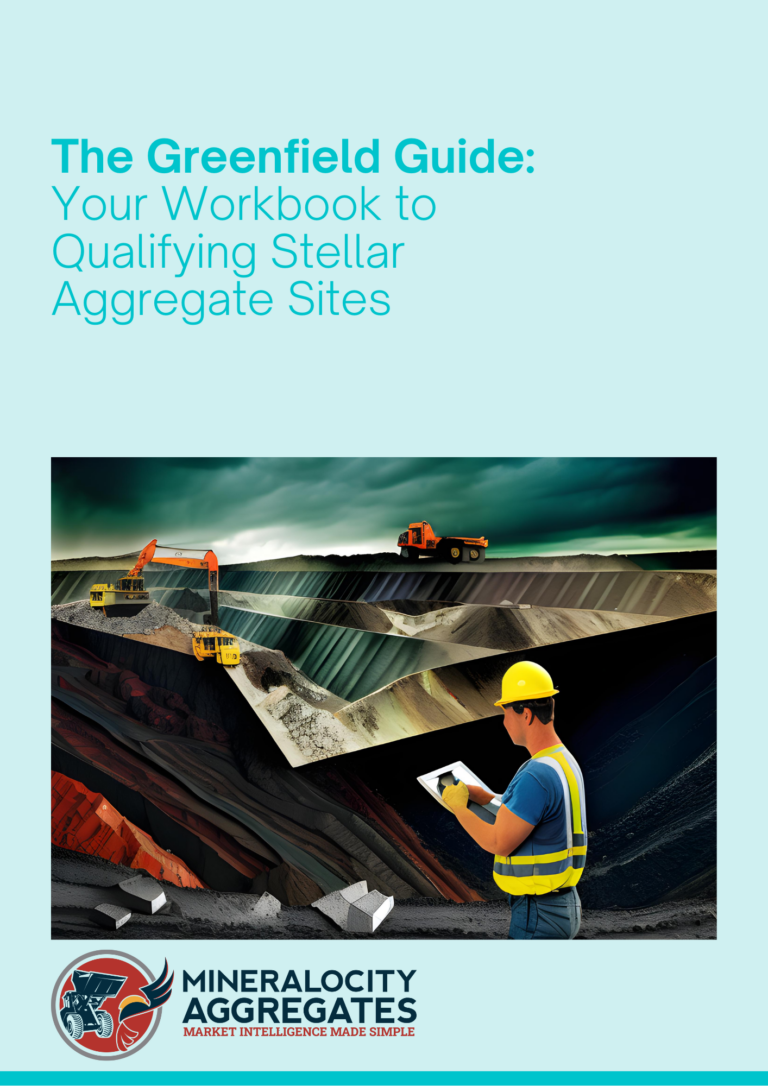
Dive deeper into the world of construction aggregate production with our exclusive Greenfield Guide. Whether you’re a seasoned expert or just embarking on your aggregate adventure, this guide is your roadmap to identifying prime locations, assessing supply potential, and capturing significant market shares. Arm yourself with proven strategies, actionable insights, and essential formulas designed to propel your projects to unparalleled success. Don’t miss this chance to elevate your greenfield endeavors – grab your free copy of the Greenfield Guide now!
For those in the aggregate industry, the term “overburden” refers to the naturally occurring material that lies above the area of interest. While the valuable aggregates are the primary focus of any mining operation, overburden management is a critical aspect that often demands a significant portion of an operation’s budget and attention.
According to a study by the U.S. Bureau of Mines, the average cost of overburden removal in the United States is $1.50 per cubic yard. These costs can fluctuate based on factors like the type of overburden, the mining equipment used, and the mine’s location. Over the lifespan of a mining operation, these costs can stack up significantly, making efficient and cost-effective overburden management essential.
While it’s a component that doesn’t directly generate revenue – being unsellable in its natural state – overburden can, if managed correctly, be transformed from a cumbersome expense to an opportunity. In this article, we’ll delve into the true cost of overburden, its impact on operations, and strategies to turn this challenge into a potential advantage.
Overburden refers to the layers of soil, sediment, and rock that overlay the mineral deposit of interest. Removing it is essential to access the aggregates, but the process can be time-consuming, expensive, and even environmentally challenging.
Overburden, while a universal aspect of aggregate operations, is not uniform. It can vary dramatically from one site to another, ranging from just a few feet in depth to layers that span dozens of feet. The variation in overburden depth and type can have significant implications for a project’s cost and timeline.
Operational Costs: The act of removing overburden is resource-intensive. Physically moving it requires machinery, fuel, and labor. The thicker the overburden layer, the higher the cost of excavation. Additionally, sites with extensive overburden depths might require more specialized equipment and techniques, further driving up expenses.
By understanding the intricacies and potential costs associated with overburden in a specific site, operators can develop a more effective and cost-efficient strategy to manage it.
Managing overburden effectively demands a blend of on-the-ground experience and data-driven insights. Platforms like Mineralocity Aggregates offer comprehensive tools that can assist operations in understanding underlying geology of potential greenfield sites, while companies like Burgex Mining Consultants can assist with predicting removal costs, mine planning, and strategizing the handling of overburden. By incorporating modern technology into traditional practices, aggregate operations can transition from merely managing overburden to masterfully manipulating it for maximum benefit.
Overburden management is, undeniably, a challenge. Still, with the right strategies and tools in place, what once was a costly and cumbersome process can be streamlined and even monetized. Remember: every ton of overburden stands atop valuable aggregate. By refining your approach to this unsellable material, you ensure a smoother, more profitable pathway to the riches below.

Dive deeper into the world of construction aggregate production with our exclusive Greenfield Guide. Whether you’re a seasoned expert or just embarking on your aggregate adventure, this guide is your roadmap to identifying prime locations, assessing supply potential, and capturing significant market shares. Arm yourself with proven strategies, actionable insights, and essential formulas designed to propel your projects to unparalleled success. Don’t miss this chance to elevate your greenfield endeavors – grab your free copy of the Greenfield Guide now!
In the realm of construction aggregates, producers are constantly on the lookout for strategies to optimize production, reduce costs, and maintain quality. While establishing new sites can bring about fresh opportunities, there’s also great potential lurking beneath existing operations. By “digging deep” into your current site, you can unearth ways to enhance production and ensure the longevity of your operations. Here’s how:
Optimal equipment utilization is about much more than just using machinery. It’s about understanding, adapting, and innovating to ensure that every piece of equipment contributes effectively to the production goals. By focusing on these areas, you can ensure you’re getting the maximum return on equipment investments.
Maintenance and Upkeep: Regularly maintaining your equipment ensures it runs at its optimum capacity. Scheduled checks, preventive maintenance, and timely replacements of worn-out parts can prevent unexpected downtimes, ensuring consistent production rates.
Maximizing Equipment Runtime: By scheduling shifts efficiently and minimizing downtime, you can get the most out of your equipment. This might involve using real-time monitoring systems to identify and rectify issues before they escalate.
Capacity Matching: Ensure that the equipment used is suited for the job’s size and scope. Using equipment that’s too large can lead to unnecessary capital and operational expenses, while equipment that’s too small might not meet production demands.
Training Operators: An equipment piece is only as good as its operator. Training sessions for operators not only ensure safety but also ensure that machinery is used efficiently and optimally. It can significantly reduce operational errors that lead to wear and tear or reduced output.
Evaluate & Upgrade: The aggregate industry, like many others, is continually evolving with the introduction of new technologies. Periodically evaluating and potentially upgrading to more efficient or automated machinery can offer better production rates and reduce costs in the long run.
Custom Solutions: Sometimes, off-the-shelf equipment might not be the best fit for your specific needs. Considering custom solutions or modifications to existing equipment can significantly enhance production capabilities tailored to your site’s unique characteristics.
Training Programs: Equip your team with the skills to operate machinery optimally. Continuous training programs can lead to improved efficiency and reduced waste.
Optimize Workflow: Review your current operational flow. Identify bottlenecks and strategize on how to eliminate them to achieve a more streamlined production process.
Re-evaluate Extraction Methods: Depending on the geological nature of your site, switching up your extraction methods might yield better results. Consider methods that minimize waste and ensure a higher recovery of materials.
Recycling and Reuse: Consider investing in equipment that can recycle used aggregates. This not only reduces waste but can also lead to cost savings in the long run and has proven to be a great business model within metro areas.
Advanced Testing: Embrace advanced testing methods to ensure that your aggregates meet industry standards. This will help maintain client trust and reduce the chances of product returns. You may also find that your resource has the potential to produce additional products and open new potential markets.
Feedback Loops: Create a system where feedback from the end-users of your aggregates is actively collected and acted upon. This can lead to improvements in product quality and better meet market demands.
Site Assessment: Continually assess your site to identify untapped sections that might contain high-quality aggregates. Techniques such as exploratory drilling can offer insights into the depth, extent, and quality of these reserves.
Update or Create Mine Plans: If you’re operating based on older mine plans, it might be time for a revisit. As technology advances and new data becomes available, mine plans can be refined for better optimization. An updated mine plan can help pinpoint exact locations for extraction, ensuring minimal waste and efficient resource utilization.
Lacking a Plan?: If your operation hasn’t had a formal mine plan in place, now is the perfect time to develop one. A well-crafted mine plan guides operations, ensuring that resources are extracted in a logical and sustainable manner. It can also act as a roadmap for future expansions, helping operations forecast potential obstacles and opportunities.
Collaboration with Geologists and Engineers: To create or refine a mine plan, it’s beneficial to collaborate with geologists and mining engineers. Their expertise can help make sense of the data gathered from exploratory drilling and other assessment methods, transforming it into actionable strategies.
Regulatory Compliance: Updated mine plans can also ensure that your operations stay in line with local and federal regulations. This can help avoid potential legal hurdles and ensures the sustainability of your operations in the long run.
Hiring Consultants: Bringing in external expertise, like Burgex Mining Consultants can provide fresh perspectives on your operations. They can identify areas of improvement that might have been previously overlooked and provide strategies to tap into them.
Investing in technology doesn’t mean just buying the latest gadgets. It means integrating modern tools and approaches into the aggregate production process to enhance efficiency, reduce costs, and increase output. In the rapidly evolving technological landscape, staying updated and making informed tech investments can give aggregate producers a competitive edge.
Automation: As the industry progresses, automation solutions have become more accessible and practical. Automated systems in production, loading, and transport can significantly improve efficiency and reduce labor-intensive tasks. Automated crushers, for instance, can optimize rock crushing, and automated conveyor belt systems can increase the transport speed of materials.
Real-time Monitoring: Deploy sensors and equipment fitted with IoT (Internet of Things) capabilities. These can provide real-time data about equipment health, production rates, and operational inefficiencies. By identifying issues as they arise, producers can make instantaneous adjustments, leading to consistent and optimized production.
Data Analytics: With the large volumes of data generated from real-time monitoring, utilizing data analytics can offer actionable insights. By analyzing patterns, you can anticipate maintenance needs, adjust for efficiency, and forecast production capabilities.
Drones: Utilize drones for site mapping, stockpile measurements, and monitoring. Drones can provide accurate data faster and more safely compared to manual inspections, enabling better decision-making.
Software Solutions: Invest in software tailored for the aggregate industry. Software solutions can aid in tasks ranging from inventory management and production tracking to predictive maintenance and financial forecasting.
Sustainable Technologies: With increasing emphasis on sustainability, look into technologies that reduce emissions, recycle water, and minimize waste. For instance, electric-powered equipment might offer a sustainable alternative to diesel-powered machinery in certain applications.
Mobile Applications: Equip your on-ground teams with mobile applications that allow them to report, monitor, and communicate more effectively. This can significantly streamline operations and improve response times to any challenges that arise.
Enhancing production in existing aggregate sites is all about understanding your current resources and optimizing them. With a keen focus on continuous improvement and a willingness to adapt to modern methods and technologies, producers can ensure that their sites continue to yield high-quality aggregates for years to come. For those looking to dive even deeper into the nuances of the aggregate market, tools like Mineralocity Aggregates offer invaluable insights to stay ahead in this dynamic industry.
Unlock the untapped potential of over 10,000 U.S. commercial mining operations mapped on our platform, Mineralocity! Dive into our supply and demand grids, explore detailed geology with production analysis, evaluate surplus and distribution, take advantage of our extensive rail/transport data, and stay ahead with population trends and more! From aggregates to precious metals, Mineralocity brings a wealth of mining data and insights right to your fingertips!
